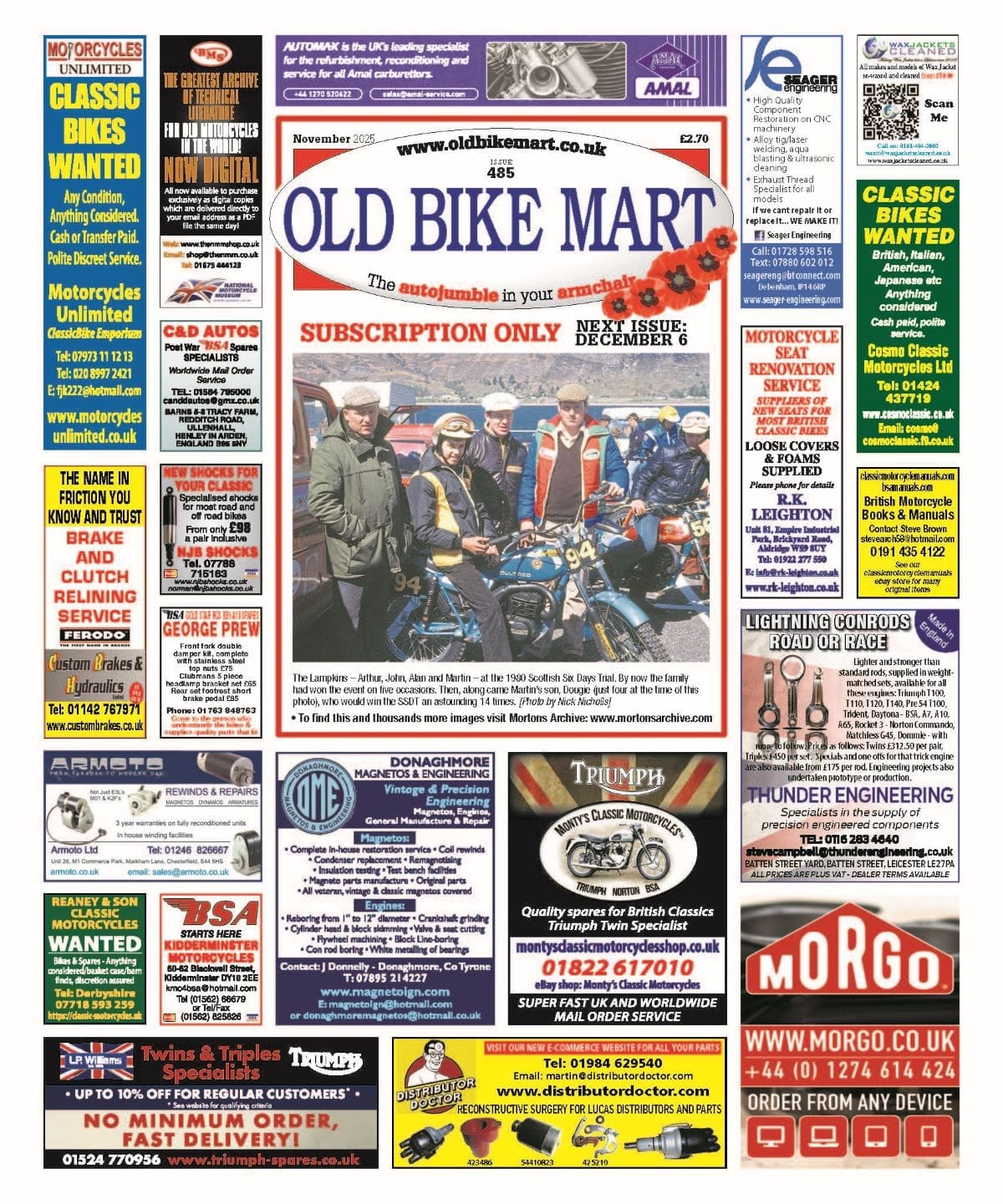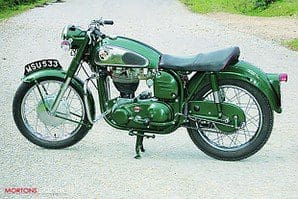
Years ago, I was about to buy a Featherbed-framed Norton Model 50 just like this one, until the vendor reneged on the deal. “You probably wouldn’t have liked it anyway, because it’s not very fast,” he said, using the common criticism of this model to soften the blow, before revealing that his son-in-law had persuaded him that the Norton should stay in the family.
If the son-in-law’s motives were financial, as I suspect, then he might have been rather disappointed. Despite the general popularity of Featherbed-framed Nortons, the value of the relatively rare ohv singles (the 350cc Model 50 and the 500cc ES2 were only produced for three years after 1959) has never matched that of contemporary Dominators.
The model names had been familiar since pre-WWII days, of course, but it was ages before these machines were finally given Featherbed frames similar to those used on Dominator twins. And in doing this, I don’t suppose Norton (which never got sufficient encouragement or investment from its Associated Motor Cycle management) had anything other than production economies in mind. The all-welded frames may have been high-tech, but the engines that were transplanted into them were frankly old-hat, and were recognisably related to power units that had been around as long as the model names.
Enjoy more classic motorcycle reading, Click here to subscribe to one of our leading magazines.
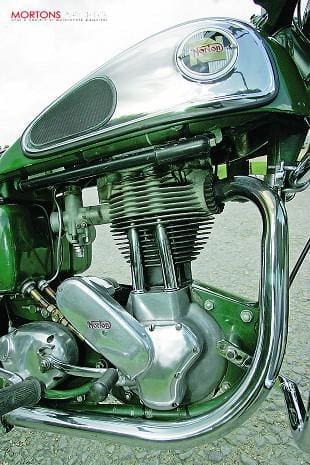 As a result they were considerably less poky than their Dominator siblings, and that was the kiss of death in the minds of many potential buyers. Meanwhile, the relatively few folk who still wanted a traditional single continued to buy an AJS or a Matchless, and so the Featherbed singles never became particularly popular or numerous.
As a result they were considerably less poky than their Dominator siblings, and that was the kiss of death in the minds of many potential buyers. Meanwhile, the relatively few folk who still wanted a traditional single continued to buy an AJS or a Matchless, and so the Featherbed singles never became particularly popular or numerous.
With hindsight, it could all have been so different. Admittedly, Norton had little incentive to promote the singles, as they could sell all the Dominators they could make; but if the will had been there, the M50 and ES2 could easily have been developed into Gold Star-type fast roadsters. And without too much further effort or investment they might even have become worthy successors to the iconic, but uneconomic, overhead cam Norton Internationals. In either case, they could have been retailed at a hefty premium, but they were aggressively priced instead, and sold for little more than any of their immediate competitors.
That meant that Norton could report increased sales of their ohv singles, but they still didn’t sweep the market before them. Why? After all, here was a machine whose engines had the same reliability and performance as their AJS or Matchless stablemates (or a BSA or Royal Enfield, come to that) but which was housed in the fabled race-bred Featherbed chassis. ‘Ay, there’s the rub,’ as Hamlet said. It seems that some people felt that the entire motorcycle was somehow diminished by the apparent mismatch between performance and potential, and surprisingly, that feeling appears to have persisted into more modern times. Some years ago, a predecessor in TCM tested a Model 50 like the one I’m riding today, and his report appeared under the cheeky headline, ‘Nice face, shame about the legs’.
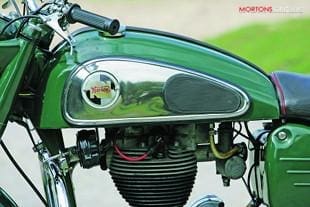 Was that a fair assessment, or was it simply reflecting the knee-jerk reaction that anything other than an outright sportster coming from Bracebridge Street was bound to be a disappointment? Riding Pete Mullard’s nicely preserved example of the breed will give me a chance to find out, but I can anticipate Pete’s own answer to the question. I’ve seen him riding his Model 50 on club runs for the last dozen years or so, and you don’t stick that long with a bike if it doesn’t suit you.
Was that a fair assessment, or was it simply reflecting the knee-jerk reaction that anything other than an outright sportster coming from Bracebridge Street was bound to be a disappointment? Riding Pete Mullard’s nicely preserved example of the breed will give me a chance to find out, but I can anticipate Pete’s own answer to the question. I’ve seen him riding his Model 50 on club runs for the last dozen years or so, and you don’t stick that long with a bike if it doesn’t suit you.
“Yes,” he says, “I like it, and I’ve had it much longer than you’re aware of. In fact when I first got the Norton, it was too young for VMCC events, so I used to take it round the country show circuit. What’s more,” he continues to my considerable amazement, “it cost me practically nothing, as it would have gone for scrap if I hadn’t rescued it.”
Hampshireman Pete was a welder by trade, and like most of his generation was a motorcyclist in his youth, starting off with a BSA C11 before graduating to a B31, a Velocette MAC and a 1952 Vincent Comet. He obviously never developed any particular brand loyalty, and he never previously owned a Norton, a fact I mention to show that his enthusiasm for the Model 50 genuinely reflects its attributes, rather than rose-tinted bias, or a desire to rekindle his youth.
 Pete’s riding continued during his National Service, as he was lucky enough to become a dispatch rider. The variety of mounts he was provided with did include a Norton 16H, but that’s so far removed from an ohv Featherbed that even Bracebridge Street’s greatest fan wouldn’t expect it to create great enthusiasm for the classic marque.
Pete’s riding continued during his National Service, as he was lucky enough to become a dispatch rider. The variety of mounts he was provided with did include a Norton 16H, but that’s so far removed from an ohv Featherbed that even Bracebridge Street’s greatest fan wouldn’t expect it to create great enthusiasm for the classic marque.
As is often the case, a significant break from motorcycling ensued as Pete brought up his family, and, but for fate, it might have continued indefinitely. One day in 1980, though, Pete – by now the foreman in a local firm making caravan chassis and trailers – came to work and saw a sorry-looking Norton leaning against the scrap metal skip. Asking his boss what it was doing there, he received the negligent reply. “Oh, I found it in a customer’s garden, so I said I’d take it away and get rid of it along with our own scrap. I just haven’t got round to putting it in the skip, so you can have it if you like.”
Well, you don’t look a gift horse (or a Norton) in the mouth, do you? Pausing only to ask his boss to retrieve the logbook from the customer as well, Pete wheeled his new toy away. The paperwork was recovered, and Pete duly became only the Norton’s third owner. For some reason, it was given an age-related registration, but its original number could be restored if he still has the documentation.
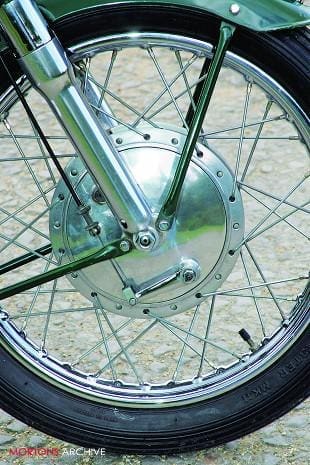 Even in 1980, people didn’t chuck away pristine motorcycles, and the Model 50 was in a bit of a state cosmetically, so a full restoration was called for. “That didn’t cost too much either,” grins Pete, “as I applied the cellulose (a close match to Norton’s rather uninspired Forest Green) in the spray booth at work, and I sent the chromed parts off to a local electro-plater, along with the firm’s regular consignment. Even the engine didn’t need too much done to it. I re-ringed the piston, and reconditioned the cylinder head, but the bottom end was OK, and it still is!” The wheels had to be re-rimmed, and that’s one job that’s recently been redone as Pete wasn’t happy with a ‘kick’ when the first ones were spun.
Even in 1980, people didn’t chuck away pristine motorcycles, and the Model 50 was in a bit of a state cosmetically, so a full restoration was called for. “That didn’t cost too much either,” grins Pete, “as I applied the cellulose (a close match to Norton’s rather uninspired Forest Green) in the spray booth at work, and I sent the chromed parts off to a local electro-plater, along with the firm’s regular consignment. Even the engine didn’t need too much done to it. I re-ringed the piston, and reconditioned the cylinder head, but the bottom end was OK, and it still is!” The wheels had to be re-rimmed, and that’s one job that’s recently been redone as Pete wasn’t happy with a ‘kick’ when the first ones were spun.
Apart from that, nothing much has needed doing in the last 26 years; the last part of the restoration being the fitting of the chromed tank panels that were missing when the bike was recovered. Even the crash-bar and the handlebars were on the bike as found, and apart from the tank panels, the only significant omissions were the toolbox lid (a friend gave Pete a replacement) and the bottom half of the rear chaincase. That’s still missing, but I can tell Pete that it’s no great loss, as a poor fit at the bottom of the Norton case enables it to swallow copious amounts of road grit, which can easily turn into a grinding paste. It’s much better to have the chain in the open where you can regularly check its tension and lubricate it.
Well, like I say, this bike has now been in regular use for a considerable time. Pete’s unsure exactly how many miles he’s covered, because he’s had a new speedo fitted, but it can usually be measured in thousands per year. And in all that time, his Norton’s never let him down, which must be a tribute both to his restoration, and to the soundness of its design.
 It’s also very, very, user friendly. I suppose there are still Luddites around who think that the world stopped when coil ignition took over from magnetos, but there’s no doubt that the coil’s fat spark at zero cranking speed makes an engine much easier to start. Like most of the bigger singles, the M50 has a valve lifter, but its modest compression ratio means that it’s hardly needed. A casual kick normally does the business, and then the engine settles down to a metronome-like tickover.
It’s also very, very, user friendly. I suppose there are still Luddites around who think that the world stopped when coil ignition took over from magnetos, but there’s no doubt that the coil’s fat spark at zero cranking speed makes an engine much easier to start. Like most of the bigger singles, the M50 has a valve lifter, but its modest compression ratio means that it’s hardly needed. A casual kick normally does the business, and then the engine settles down to a metronome-like tickover.
That’s what you’d expect from a long-stroke, heavily flywheeled, machine, of course, and performance on the road is also what you’d expect from this type of machine. That is to say – not very thrilling. Now, if you were brought up on hot Japanese strokers, that would be an indictment, but to be honest, anyone who buys a bike like this and expects excitement hasn’t done his homework.
‘As it is, you get exactly what it says on the box, and that’s solid pulling power, plus reliable cruising at anything up to 60mph or so. In the unlikely event of having to use third gear on steep hills, 60mph is still available, and the AMC gearbox encourages instant changes.’
The maximum velocity is some 15mph higher, but the tall gearing (60mph only sees the engine spinning at 4000rpm) means that you’ll probably reach your destination before you achieve absolute top whack. But that doesn’t mean that your ride is tedious, because you’ll probably be surprised at just how quickly you actually reach your destination. You won’t be blowing speed cameras’ fuses along the straights, but you’ll certainly have the fast boys blowing gaskets trying to keep up with you in the twisties. And the great thing is, you probably won’t even know they are there, because riding quickly is so effortless.
You don’t really need me to restate that the Featherbed frame is the best thing since sliced bread, but it’s a fact that if you are used to almost any other classic machine, riding a duplex-framed Norton will see you unintentionally cornering faster than you are used to. Additionally, among all the hype about the Featherbed frame it often goes unreported that Norton’s brakes were as good as they came in classic days (with the honourable exception of the double drums on Vincents). And any racer will tell you that stopping is just as important as acceleration when it comes to maintaining a high average speed.
It’s all so effective that I can see how it highlights the M50’s apparent mismatch between potential and performance. But it’s a fact that very few other motorcycles have engines and cycle parts that reach their limits simultaneously. If you want a couple of instances, think about the reputation gained by early Bonnevilles, whose souped up engines caused all sorts of heart-stopping moments when they were plonked into the type of frame that had been perfectly satisfactory in other applications. And a heavyweight late-vintage sportster’s combination of illegal speeds and moped-style brakes can give you any amount of excitement.
 Well the Model 50 is undeniably at the other end of the frame/engine spectrum, with a ride-to-work engine allied to a race-winning chassis. And whether that is its downfall or its salvation depends on your personality. Adrenaline junkies will be disappointed by the Model 50, as unless they are totally inept or unlucky, they’ll always run out of power before they run out of road.
Well the Model 50 is undeniably at the other end of the frame/engine spectrum, with a ride-to-work engine allied to a race-winning chassis. And whether that is its downfall or its salvation depends on your personality. Adrenaline junkies will be disappointed by the Model 50, as unless they are totally inept or unlucky, they’ll always run out of power before they run out of road.
If, on the other hand, you simply want to get around safely, comfortably, and surprisingly quickly, then the Model 50 could well be the machine for you. And the good news is that the motor’s unstressed, imperturbable, nature means that even if you use all it can deliver, you’re unlikely to damage it. I noted that Pete only did a top-end overhaul when he put his bike back on the road, and although the bottom end hasn’t been touched in nearly half a century since it left Bracebridge Street, I can confirm that it’s still as smooth and quiet as can be. And incidentally, the mechanical silence might surprise owners of other makes – and older Nortons – as Bert Hopwood’s 1948 revisions to their valve gear made the later ES2s and 50s some of the most civilised singles around.
As I suspected, Pete’s liking for his Model 50 was never really in doubt, and he has no desire for a change. The only way another bike would join it in the garage is if he wins the VMCC’s current raffle, where the prize is a 1952 Vincent Comet just like the one he used to own. “That would be all right, wouldn’t it,” he grins, “because it would come virtually free, just like the Norton!”

